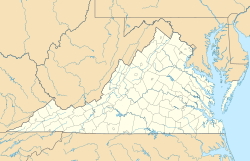Waterford, Virginia | |
|---|---|
 The Waterford town center in July 2008 | |
| Coordinates: 39°11′12″N77°36′36″W / 39.18667°N 77.61000°W | |
| Country | |
| State | |
| County | |
| Area | |
• Total | 0.36 sq mi (0.94 km2) |
| • Land | 0.36 sq mi (0.94 km2) |
| • Water | 0 sq mi (0.0 km2) |
| Time zone | UTC−5 (Eastern (EST)) |
| • Summer (DST) | UTC−4 (EDT) |
| ZIP code | 20197 |
| FIPS code | 51-83440 |
| GNIS feature ID | 2807429 |
Waterford Historic District | |
 The Waterford Mill | |
| NRHP reference No. | 69000256 |
|---|---|
| VLR No. | 401-0123 |
| Significant dates | |
| Added to NRHP | June 3, 1969 [2] |
| Designated NHLD | April 15, 1970 [3] |
| Designated VLR | May 13, 1969 [4] |

Waterford is a historic village located in western Loudoun County, Virginia, United States. Waterford lies forty-seven miles northwest of Washington, D.C. and seven miles northwest of Leesburg. In 1970, the village was designated a National Historic Landmark District in recognition of its well-preserved eighteenth- and nineteenth-century character.
Contents
- History
- 18th century
- 19th century
- 20th century
- National Historic Landmarks
- Demographics
- See also
- References
- External links
In the 1810 United States census, the population center of the United States was recorded as being just northwest of the village. [5]





